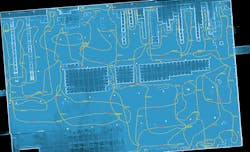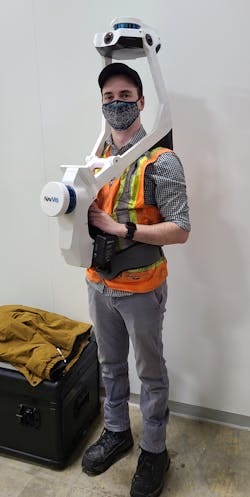One of the newest tools used in the plant and processing world to create an accurate representation of existing facilities or equipment is 3D laser scanning. An understanding of how the technology works as well as the advantages and disadvantages of the different types of laser scanners is required to effectively leverage 3D scanning in any project and maximize its benefits.
How 3D laser scanning technology works
A terrestrial light detection and ranging (LiDAR) scanner (commonly referred to as a 3D laser scanner) is a tool that uses laser beams to create a detailed three-dimensional map /model of a subject item, commonly referred to as a point cloud. The scanner consists of a laser emitter, a sensor and a computer system that processes the data.
The scanner is set up on a stationary tripod in the area to be scanned. During operation, the scanner directs a pulsed laser beam toward the subject item. When the pulsed laser beam hits an item’s surface, it reflects back toward the scanner. The scanner’s sensor detects the reflected laser beam and records the returned laser signal’s intensity and time of flight (i.e., how long it took for the beam to go from the emitter to the item and back to the sensor). This information is used to determine the item’s distance from the scanner, as well as the item’s surface characteristics.
The scanner rotates and changes the angle of the laser beam to scan the entire area visible from its location. Depending on the scanner’s specifications, it can capture millions of data points in seconds. These data points are then processed by a computer system, which aligns the individual scans like a 3D jigsaw puzzle to create the point cloud. The point cloud is a collection of millions of points in a 3D coordinate system. The point cloud data can then be processed and analyzed in engineering and/or design software to create an accurate and detailed 3D representation of the scanned area.
A mobile 3D scanner works in a similar fashion. The mobile scanner consists of a laser emitter, sensor and computer system, just like the terrestrial scanner. However, the mobile scanner also includes an inertial measurement unit (IMU). An IMU is an electronic device that measures and reports a moving object's acceleration, orientation and angular velocity. It typically consists of three accelerometers and three gyroscopes that work together to provide accurate measurements of the object's motion. The data collected by the IMU creates a “string” that is tied to the scan data. The data is then processed by a computer to create the 3D point cloud.
Terrestrial versus mobile scanning
Terrestrial and mobile scanners each have advantages and disadvantages. Terrestrial scanners can capture extremely high-resolution data with a high level of accuracy, but since they are typically mounted on tripods, they are limited in their range of movement. Additionally, in comparison to mobile scanners, scanning large subject items with a terrestrial scanner can be time consuming, as it requires multiple setups and scans from different angles to be able to scan all features.
Mobile scanners typically capture lower-resolution data with a lower level of accuracy. However, since the scanner can be moved around the subject item, they are ideal for quickly capturing data from a variety of angles. Mobile scanners have a lower accuracy than terrestrial scanners due to their reliance on GPSs or IMUs to determine their location and orientation.
Terrestrial scanners are ideal for scanning stationary items with a high level of precision for detailed design, while mobile scanners are best suited for scanning large items quickly for most preliminary designs or for general layouts.
While mobile scanners are generally less accurate than terrestrial scanners, they can capture large areas quickly, which can allow for a hybrid scanning approach, where a mobile scan is completed for the larger areas, and then a second terrestrial scan is completed in areas requiring additional accuracy or detail.
How 3D scanning saves time and effort
3D scanning can save time by quickly capturing detailed information about a facility or equipment. Often, the time savings alone may justify including 3D scanning in a project. Rather than erecting scaffolding to take manual measurements and making multiple trips to the facility to verify dimensions, process designers can use 3D scanning to capture precise measurements and details in a matter of seconds or minutes.
This also allows detailed information to be available to all team members at the onset of a project. All team members can virtually see and become familiar with the site regardless of their physical location and any site-specific training requirements that would need to be completed.
Additionally, knowing more information at the beginning of a project will allow for more detailed and better design choices. With a detailed scan, any “no-go’s” can be determined at the onset of the project, and design work can start by accommodating any detailed considerations at that time. For example, when designing vacuum system ducting, the entire facility can be captured quickly with a mobile scanner to determine possible routes for the ducting and select an optimal route. Alternatively, the mobile scan can be used to model the existing system to allow for calculations to be completed to resize equipment such as fans or blowers.
Since the scan data (data) is an accurate representation of the facility, it can be reused, thus saving even more time. When starting a new project, the previous data can be used as a jumping off point and provide a basis for orientating the project’s requirements. For example, when putting a new tank into an existing site, a 3D model of the new equipment can be placed into the previous data to determine initial project constraints.
How to best leverage 3D scanning technology
One of the best ways to leverage 3D scanning technology is when retrofitting within existing infrastructure. In many cases, there is a lack of existing drawings or documentation for use when building new work onto existing facilities. Without existing information, it can be challenging to obtain accurate measurements and dimensions of an object, especially for complex facilities, equipment, or structures. 3D scanning alleviates the need to have existing drawings by capturing detailed, precise, and accurate data.
This can be incredibly helpful when repurposing or relocating existing items throughout a facility, as the dimensional information on all existing infrastructure is captured and can be accommodated during the design process. An example is scanning existing equipment to obtain accurate details to perform a finite element analysis. A vessel can be scanned and the data used to create a model, then an analysis can be performed to determine the vessel’s maximum rated pressure. This is important for combustible dust explosion protection (Pred).
Additionally, 3D scanning is helpful when attempting to re-engineer existing systems where no documentation exists. For older existing facilities, a significant amount of equipment is still in use that needs to be replaced, but no new parts are being manufactured. In these cases, manufacturing an exact replacement is necessary. With 3D scanning, engineers can extract the precise dimensions from the scan data and create an accurate 3D model for fabricating a replacement.
With 3D scanning, it is possible to obtain dimensional information for places that are either inaccessible or where taking measurements by hand would pose a safety risk. Confined spaces, for example, have limited egress and can pose a serious health risk for workers entering; however, in most instances, a 3D scanner can be placed either inside or adjacent to the confined space to capture the dimensional information and avoid the need to place anyone at risk.
Areas that have radiological, chemical, or dust hazards are also typically inaccessible. By using a 3D scanner to capture information, companies can reduce or limit exposure to environments that can cause negative health effects. While the scan technician will need to access the hazardous area, they typically can set up the scanner and then leave the environment to minimize exposure, or alternatively, the technician may be able to capture the necessary information with the scanner set up outside the hazardous environment. One example is placing the scanner inside a vessel (which is typically a confined space). The scanner can capture the vessel’s internal details while the scan technician remains safely outside, eliminating the need for confined space entry requirements.
Additionally, when access is limited due to the operation of the equipment, 3D scanning can be an effective method of measuring existing conditions. When equipment is operating, it can be challenging to accurately measure some critical features, and it can be very time consuming to complete some measurements when equipment is not operating. 3D scanning can capture millions of data points in a matter of minutes, allowing for operations to resume with minimal downtime.
Logan Vandenberg is a project coordinator at Element6 Solution's Georgetown, Ontario, office. He is a graduate of the civil engineering technology program from Humber College and has extensive knowledge in both surveying and reality capture as well as 3D CAD applications.
Element6 Solutions




